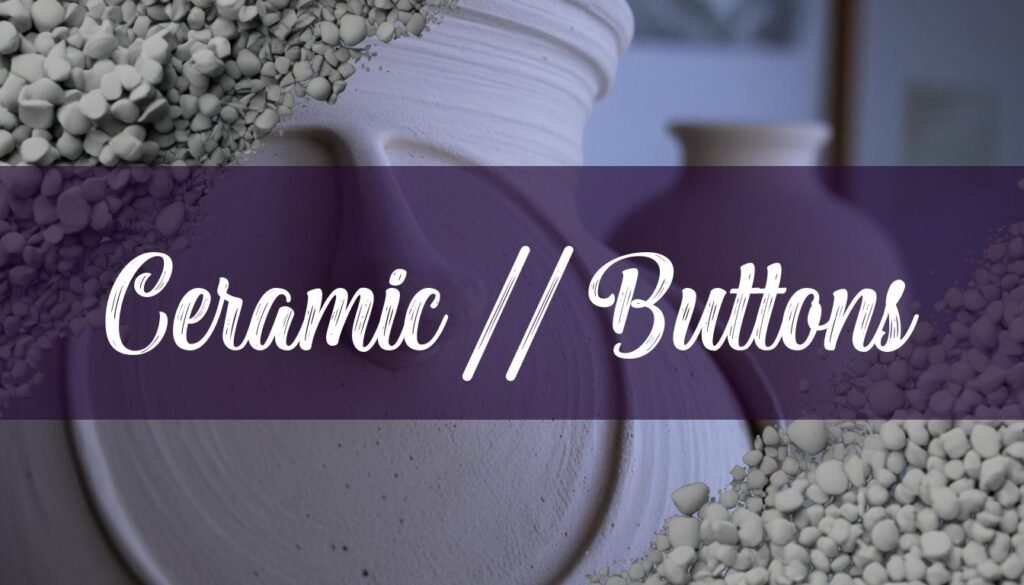Creating ceramic buttons at home is a rewarding endeavor, blending artistry with functionality. It’s a chance to infuse your garments and craft projects with unique, handmade elements. The process involves selecting the right clay, shaping it, creating buttonholes or shanks, decorating, glazing, and finally, firing your creations in a kiln. Each step offers opportunities for creative expression, resulting in buttons that are not only useful but also miniature works of art.
The journey begins with gathering the necessary tools and materials. Clay, of course, is the star of the show, and choosing the right type is crucial. Then you will need tools for shaping, piercing, and finishing the buttons. Glazes are essential for adding color and durability, and a kiln is required for firing the clay to harden it and bring out the glaze’s true colors. Safety gear, such as gloves and eye protection, is also important, especially when handling glazes and operating the kiln. With these essentials in hand, you’re ready to embark on the button-making adventure.
Choosing the Right Clay and Tools
Selecting the appropriate clay is paramount for successful ceramic button making. The properties of different clay types—such as shrinkage rate, firing temperature, and durability—directly impact the final product. Stoneware clay is often considered the most versatile and easiest to work with, making it a great choice for beginners (Read more about buying clay for pottery). It is durable, strong, and becomes non-porous when fired at higher temperatures, typically between 1200°C to 1300°C (2200°F to 2372°F) (More information on the different types of clay.). This makes it suitable for buttons that need to withstand regular use and washing.
Earthenware clay, known for its low firing temperature (around 1000°C to 1150°C or 1832°F to 2102°F), is another option, especially for those without access to high-temperature kilns (Read more about buying clay for pottery). However, it remains porous after firing unless glazed, so glazing is essential for durability and functionality (Read more about the different types of clay). Porcelain clay, prized for its smooth, translucent finish, is more challenging to work with due to its fineness and high firing temperatures (1,200 °C to 1,400 °C or 2,200 °F to 2,550 °F) (Read more about buying clay for pottery). For those seeking an alternative to traditional ceramic clays, air-dry clays like Sculpey Air-Dry™ Clay offer a porcelain-like finish and are suitable for mixed-media projects (Learn more about clay for sculpting). You may also want to consider sourcing clay locally to enhance your connection with the craft.
Beyond clay, essential tools include shaping tools such as knives, needle tools for creating holes, and sponges for smoothing surfaces. Molds can be used to create uniform shapes, and stamps or carving tools can add texture and unique designs (Read more on making ceramic buttons). A kiln is necessary for firing the buttons, and safety equipment like gloves and eye protection should always be used when handling materials and operating the kiln. If you are new to firing, you can read about kiln care 101 for some helpful information.
Shaping, Texturing, and Creating Buttonholes
Once you’ve selected your clay and gathered your tools, the next step is shaping the buttons. There are several techniques you can use, depending on your desired aesthetic and skill level. Hand-building techniques like pinching, coiling, and slab construction offer a direct, tactile approach to shaping the clay. Pinching involves forming the clay between your fingers to create a small, rounded button. Coiling involves rolling out coils of clay and joining them together to build up the button’s form. Slab construction uses flat sheets of clay cut and assembled to create various shapes.
Press molds can be used to create uniform button shapes quickly and easily (Read more on making ceramic buttons). Simply press the clay into the mold, remove the excess, and release the shaped button. Wheel throwing, while typically used for larger ceramic pieces, can also be adapted for button making, allowing you to create perfectly round and symmetrical buttons. Regardless of the shaping method, it’s important to ensure the buttons are of uniform thickness and size for a cohesive look. Texturing adds visual interest and depth to your ceramic buttons. You can use a variety of tools and techniques to create different textures, such as stamping with textured objects, carving with sharp tools, or impressing patterns with found objects like leaves or lace.
Creating buttonholes or attaching shanks is a critical step in making functional buttons. Buttonholes can be created by piercing the clay with a needle tool while it is still wet. The number and placement of holes will depend on the design and intended use of the button. Shanks can be made by attaching a small loop of clay to the back of the button. This loop provides a space for the thread to pass through when attaching the button to fabric. Ensure that the buttonholes or shanks are securely attached and properly sized before firing to avoid any issues later on.
Glazing, Firing, and Troubleshooting
Glazing is an exciting stage in the ceramic button-making process, offering a chance to add color, shine, and durability to your creations. There are many different types of glazes available, each with its own unique properties and effects. Underglazes can be applied to the clay before firing to create intricate designs and pops of color (Read more on making ceramic buttons). These glazes don’t melt or run during firing, allowing for precise detailing. Overglazes, on the other hand, are applied after the initial firing and create a glossy, glass-like surface.
Various decorating techniques can be employed to enhance the appearance of your ceramic buttons, including painting, stamping, carving, and applying decals (Read more on making porcelain buttons). Each technique offers a different aesthetic and level of detail. Painting with underglazes allows for intricate designs and patterns. Stamping with textured stamps creates repeating patterns and adds visual interest. Carving into the clay reveals the underlying material and creates a tactile surface. Applying decals adds pre-printed designs to the surface of the button.
Firing is the final and crucial step in the ceramic button-making process. It involves heating the clay to a high temperature in a kiln, which vitrifies the clay and melts the glaze, creating a durable and visually appealing finish. Firing schedules vary depending on the type of clay and glaze used. Generally, a slow bisque firing is recommended to remove any remaining moisture from the clay and prepare it for glazing (Read more on kiln firing schedules). A typical slow bisque firing schedule for Cone 04 clay involves gradually increasing the temperature over several hours, reaching a final temperature of 1945°F (Read more on kiln firing schedules). The glaze firing is then performed at a higher temperature to melt the glaze and create a smooth, glossy surface. It’s crucial to use self-supporting cones to monitor the accuracy of your controller during firings (More on firing schedules). If you want to try something different, you could even try pit firing!
Despite careful planning, common problems like cracking, warping, or glaze defects can sometimes occur during the button-making process. Cracking can be caused by uneven drying or rapid temperature changes during firing (Read more on kiln firing schedules). To prevent cracking, dry the buttons slowly and evenly, and follow a gradual firing schedule. Warping can occur if the clay is not properly supported during firing or if the kiln is not level. Ensure that the buttons are placed on a flat, stable surface in the kiln to prevent warping. Glaze defects, such as bubbling, crazing, or running, can be caused by improper glaze application or firing temperatures. Apply glazes evenly and follow the manufacturer’s recommendations for firing temperatures to minimize glaze defects. If bubbles appear in the glaze, try holding the temperature at a lower point to allow them to burst (More on firing schedules). Remember to experiment with different techniques and embrace the learning process to refine your skills and create truly unique ceramic buttons.





